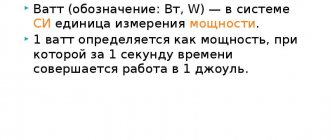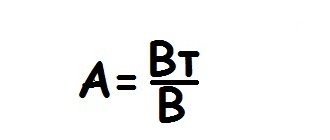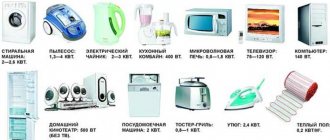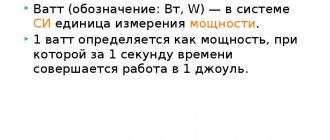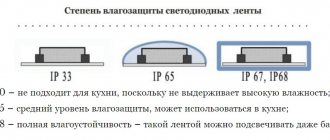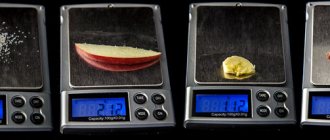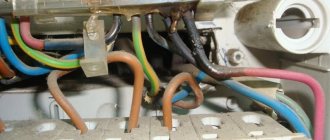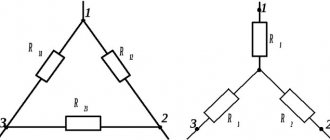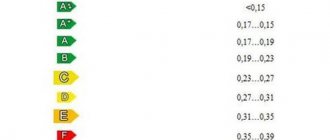Tables of ratios of amperes, volts, watts, ohms
To simplify, the main parameters of the electrical circuit are explained using the example of the functioning of a conventional pipeline. The movement of fluid is ensured by the pressure difference. The narrowing (expansion) of the transport route changes the flow resistance accordingly. If necessary, using the listed parameters or experimentally, you can set the pipeline productivity in liters per unit of time.
By analogy with the above description, the potential difference (voltage) ensures the movement of electric charges (current). As the cross-section of the conductor decreases, the electrical resistance increases. Knowing the basic parameters, it is easy to calculate the power consumption of the connected load.
The specified power data corresponds to certain resistance and voltage values. Similar tables are compiled for converting Watts into amperes and other quantities. This example clearly demonstrates the main disadvantages of the tabular form:
- complexity of processing large amounts of data;
- discreteness of information provision;
- limited accuracy.
Using calculations, you can convert volts to amperes quickly and accurately.
For your information. As an alternative, an electrical quantity converter is used, which is available for free use on reference and specialized websites on the Internet.
What is voltage, Volt [V]
By creating a potential difference, they ensure the movement of charges. The unit of measurement is one Volt. This voltage ensures the movement of 1 Coulomb (C) of electric charge between the poles. During this process, work with energy of 1 Joule (J) is performed.
The same value (V) can be represented as the potential difference to release a unit power of 1 W (W) when the current is limited to one ampere. Similarly, it is permissible to use proportions when determining the relationship between voltage and electrical resistance (R). The listed dependencies can be expressed as follows:
The simplest formulas are valid for calculating a DC network. If sinusoidal oscillations are considered, in addition to the amplitude, it is necessary to take into account the corresponding changes in voltage depending on time. The instantaneous value is described as follows:
Where:
- Ua – maximum voltage deviation (amplitude);
- w – frequency;
- t – time;
- ϕ – phase (initial).
For simplified calculations, it is convenient to use the root mean square voltage ( Uc p), which is related to the amplitude value by the following proportion:
How many amperes in a kilowatt and kilowatts in an ampere
The presented formulas show that direct conversion of power to amperes does not make sense. Depending on the calculation method, it is necessary to additionally take into account voltage or resistance. In two- and three-phase networks, corrections have to be made due to the sinusoidal shape of the signal. An additional influencing factor is the capacitive (inductive) nature of the load.
Table on how to convert watts to amperes
| Current, A | power, kWt | Minimum cross-section of the power supply conductor, sq. mm (for different materials) | ||
| 1 phase, 220V | 3 phases, 380 V | Aluminum | Copper | |
| 1 | 0,2 | 0,5 | 2,5 | 1 |
| 2 | 0,4 | 1,1 | 2,5 | 1 |
| 5 | 1,1 | 2,6 | 2,5 | 1 |
| 10 | 2,2 | 5,3 | 2,5 | 1,5 |
| 20 | 4,4 | 10,5 | 4 | 2,5 |
Read also: Do-it-yourself snow removal engine
For a fairly accurate selection of circuit breakers and cables, ready-made reference data is suitable. It is recommended to calculate watts with a reserve to prevent overheating of the conductors when connecting the maximum load.
What are Volt Amperes and how to convert them to Watts?
Another unit of measurement of power adopted in SI is Volt-ampere (VA). It is equal to the product of effective values such as current and voltage .
Additionally, it is worth noting that, as a rule, VAs are used solely to estimate the power in AC connections. That is, in cases where Watt and Volt-Ampere have different meanings.
There are now many different online calculators that allow you to quickly and easily convert VA to Watts. This procedure is so simple that we will not dwell on it.
But, especially for those people who do not have an online calculator at hand to convert Volt-amps to Watts, we will look at the process of converting these quantities in more detail:
- Energy is produced or consumed at a certain rate. And Watt is one of the units of power.
- To measure the magnitude of the electric current, A is used, which is equal to 1 Coulomb.
- Electromotive force or voltage is measured in Volts.
- In order to remember how these quantities relate to each other, you need to learn the following formula: Amps = Watts/Volts
Using this formula we can find out the current strength. Of course, only if we already know the voltage and power .
That is, it turns out that to convert Watts to Amperes, we must find out the voltage in the system. For example, in the USA the voltage in the electrical network is 120V, and in Russia it is 220V.
It is worth noting that batteries used in cars usually have a voltage of 12 V. And the voltage in small batteries used for various portable devices, as a rule, does not exceed 1.5 V.
Thus, we can say that knowing the voltage and power, we can easily find out the current strength as well. To do this, we only need to correctly use the above formula .
Let's look at how this “works” with a specific example: if the voltage is 220V and the power is 220W, then the current will be 220/220 or 1 A.
How many volts does 1 ampere contain?
As in the previous example, such questions are asked incorrectly. Converting voltage to current is possible only taking into account:
- electrical resistance of the circuit section;
- power;
- load characteristics;
- constant (variable) parameters of the power supply network.
However, it should be noted that in the Russian Federation, along with the international standard (SI), the non-system unit “Volt-ampere” is used. Its value is equal to 1 W of power, so there is no need to convert using additional coefficients. In this case we are talking about power supply with a sinusoidal signal in a single-phase network.
Volt-amp power refers to the total energy of the power source that is consumed per hour. Measure the actual voltage values at the generator terminals and the current in the connected circuit. This means that in real conditions some of the energy will be wasted on:
- thermal heating;
- electromagnetic oscillations created by reactive components.
Translation rules
One watt is defined as the power at which one joule of work is done per second. Thus, a watt is a derived measurement unit that is related to other units. A watt is equal to a kilogram multiplied by square meters and divided by cubic seconds.
In terms of other system units of measurement, a watt can be expressed as follows: in terms of a joule divided by seconds and multiplied by watts, and also in terms of a newton multiplied by meters and divided by seconds by watts. So a watt is equal to a volt multiplied by an ampere. In addition to the fact that power can be mechanical, it can also be thermal and electrical.
The prefix kilo denotes multiplication by 1000. The same principle applies in power indicators, that is, there are 1000 watts in 1 kilowatt, just as there are 1000 volts in 1 kilowatt. This means that 1 watt is 0.001 kW in reverse. That is, if you convert the power, then a 3 kW electrical appliance will be equal to 3000 watts.
If we calculate the above data, then the total power indicator of household electrical appliances will be equal to 6.385 kilowatts. This figure may be rounded up. Thanks to this amount, it is possible to calculate the wire cross-section and select the required protective automation. This way you can understand the consumption of electrical energy.
Otherwise, it will be almost impossible to find out and convert these electricity indicators. It is interesting that in new models of electricity meter, such information takes place about each connected device in the network.
Unit conversion rules
Converting kilowatts to amperes (single-phase 220V network)
How to convert watts to amperes:
- make a list of all consumers: 5 LED lamps of 15 W each, heater 2.3 kW, laptop 120 W;
- recalculate into a single format: 2.3 * 1000 = 2,300 W;
- sum up the obtained values: 75 + 2,300 + 120 = 2,495 W;
- calculate the total current when all consumers are connected simultaneously:
I (current) = P (power) / U (voltage) = 2,495 / 220 = 11.34 A.
Select the machine with the nearest higher nominal value. For this example, a 16 A protective device is suitable. The serial product is designed for a load power of up to 3,500 W, which more than covers the existing needs. The power supply network is made of copper (aluminum) conductors with a cross-sectional area of 1.5 (2.5) square meters. mm, respectively.
Why should an electronic cigarette “resist”?
Resistance (Ohm Ω) is the main characteristic of the spiral. The stronger the resistance, the less current the winding passes and the less steam the coil produces. But it is with a resistance of up to 3 Ohms that the steamer gets the maximum taste.
Due to the fact that at a low ohm more current passes, the spiral heats up more. Thus, low resistance is the key to fast heating of the winding, a high degree of liquid evaporation and, accordingly, excellent vapor clouds.
This characteristic depends on:
- Section thickness and wire length - the longer and thicker the spiral, the greater the resistance.
- Material . If you take windings that are identical in length, number of turns and width, but one of which is Kanthal and the other is made of stainless steel, then the second will always have lower resistance.
You should choose the resistance level based on the desired impressions. Sub-ohm (i.e. low-resistance) evaporators generate a lot of heat. Due to this, more liquid evaporates, and a lot of steam is produced.
It's beautiful and fragrant, but there are downsides. According to the same Ohm's law, the battery begins to work under extreme conditions, and if the settings are incorrect or the battery pack is not protected, it can leak, stop working, or even explode. At a minimum, the battery runs out much faster and the refill is consumed, and the evaporator lasts only 2-3 days. Despite the risk, professionals are chasing low Ohm.
High Ohm offers minimal risk:
- Winding heats up less, gives off better taste,
- Liquid consumption is economical
- The service life of the battery and the evaporator itself increases.
Converting amperes to kilowatts (single-phase 220V network)
An example of how to calculate watts:
- a 15A circuit breaker is installed in the electrical panel (the nominal characteristics are indicated on the housing);
- To calculate the permissible load in a 220 V , the classic formula is used:
P (power, W) = U (voltage, Volt) * I (current, Ampere).
- Substituting the original values, perform the Watt calculation:
For your information. For convenience, the result obtained can be converted into multiple units: 3,300 W = 3.3 kW (kilowatts).
What does a steamer need to know about Amperes?
Current strength (Amps) is calculated according to the famous formula I=U/R, where U is voltage and R is power. Understanding the principle of current output will be useful to the vaper when choosing a suitable battery for an electronic cigarette mod. In the case of removable batteries, the mod manufacturer usually recommends that the user install the so-called. industrial batteries with a current output of about 30 A. This is necessary so that the box mod can produce the declared power level.
Another designation familiar to the vaper is mAh on the battery, which means the number of milliamps per hour, or, more simply, the capacity of the battery. The higher the number, the more autonomy it will provide to the electronic cigarette.
In pursuit of steam volumes, many people forget about safety precautions, which can lead to a dangerous situation. Without the appropriate skills and knowledge, we categorically do not recommend modifying devices yourself.
Conversion of watts to amperes for three-phase alternating voltage
Sequencing:
- To select a suitable protective device, use the following formula:
- summarize the power of connected devices:
2,300 + 2,400 +1,800 = 6,500 W
- calculate the current in the circuit at maximum load:
6,500/(380 * 1.732) = 9.876 A.
Select a suitable machine for a three-phase network. In this example, a product rated at 10 A is suitable.
Conversion table from Volt-amps to Watts
Power losses when connecting a certain load are determined by the correction factor cos ϕ. With linear parameters (incandescent lamps, heating elements), the energy is almost completely used for useful work. In electric motors, reactive components degrade performance characteristics.
The cos ϕ is indicated in the accompanying documentation:
- 0.6-0.7 – worst indicators;
- 0.8-0.9 – average;
- 1 – minimal losses.
When connecting several devices, make a table for convenience. The calculation is made taking into account the active and reactive components.
Convert Volt Amperes to Watts, VA to kW
For calculation use the formula:
Pп (apparent power, kVA) = Pa (active power, kW)*cos ϕ.
Example:
- generator power in normal operating mode – 8 kW;
- The documentation for the connected machine indicates the power consumption:
Read also: How to connect a backlit button 3 contacts
7 kW and cos ϕ = 0.8
- When connecting such a load, the power source will not be able to provide the required operating mode:
Converting power units by dividing by voltage, converting with a calculator
To select a circuit breaker, use the following formulas:
- direct current (single-phase network 220 V ):
- three-phase network 380 V :
The data obtained will be useful for selecting wiring, sockets, and other functional components.
For your information. On specialized websites you can find a Watt calculator and other programs for automated calculations.
Video
');> //–> Formula:
P – power; U – voltage; I – current strength.
You can quickly perform this simple mathematical operation using our online program. To do this, enter the initial value in the appropriate field and click the button.
For complex calculations to convert several units of measurement into the required one (for example, for mathematical, physical or budget analysis of a group of positions), you can use universal unit converters.
This page provides the simplest online unit converter for amperes to watts. With this calculator you can convert A to W and back in one click.
International ohm - the resistance offered to a constant electric current at the temperature of melting ice by a column of mercury having the same cross-section everywhere, a length of 106.300 cm and a mass of 14.4521 g.
Ampere
The international ampere is the strength of a constant electric current that deposits 0.00111800 g of silver per second passing through an aqueous solution of silver nitrate. Ampere is divided into 1,000 milliamps or 1,000,000 microamps
Volt
The international volt is the electrical voltage that, in a conductor having a resistance of one ohm, produces a current of 1 ampere. Volts are divided into 1,000 millivolts or 1,000,000 microvolts
International watt is the power of a constant electric current of 1 ampere at a voltage of 1 volt. 1,000 watts equal a kilowatt
Pendant
International coulomb (or ampere-second) is the amount of electricity flowing through a conductor for one second at a current of 1 ampere. 3,600 coulombs equal an ampere hour
Joule
Wattsecond (international joule) is the work done by an electric current for 1 second at a current power of 1 watt. 3,600 watt-seconds is a watt-hour, 100 watt-hours is a hectowatt-hour, 1,000 watt-hours is a kilowatt-hour
Farad
The international farad is the capacitance of a capacitor charged to a voltage of 1 volt by one coulomb. Farad is subdivided into 1,000,000 microfarads
Henry
International Henry is a self-inductive circuit in which a voltage of 1 volt is induced when the current in that circuit changes at a rate of 1 ampere per second. Henry is divided into 1,000 millihenry or 1,000,000 microhenry
In ordinary practical electrical measurements, the word “international” may be omitted from the names of electrical units
Ohm's law
Resistance is designated by the letter R
or
r
and is considered, within certain limits, a constant value for a given conductor; it can be calculated as
Ohm's law
R = U/I
Where
R—resistance, Ohm;
U is the electrical potential difference (voltage) at the ends of the conductor, V;
I is the current strength flowing between the ends of the conductor under the influence of a potential difference, A.
This formula is called Ohm's law, named after the German physicist who discovered this law. An important role in calculating the thermal effect of active resistance is played by the law on the heat generated when an electric current passes through the resistance - the Joule-Lenz law:
Q = I2 R t
Where
Q is the amount of heat released over a period of time t, J;
I—current strength, A;
R—resistance, Ohm;
t — current flow time, sec.
Georg Simon Ohm
Basic quantities for alternating current
A conductor with resistance for direct current R and self-inductance L, with alternating current of frequency n (n periods or 2n changes per second) has a total resistance
If there is also capacitance C in the circuit, then the total resistance will be
There is a phase difference between the current and the applied voltage, determined by the equation
Read also: Mini garage lift
Ohm's law for an alternating current circuit has the form J = E/Rs
The power in an alternating current circuit is determined by the expression E • I • cos Ψ ; cos Ψ is called power factor
If in an alternating current circuit 2πn • L = 1/2πn • C or (2πn) 2 L • C = 1, then Rs = R a resonance in such a circuit , and Ohm’s simple law is valid for it
Current Density Measurement
The plating bath, in which metal coatings are applied, is precisely the place where it is necessary to measure the current density in a liquid conducting medium - the electrolyte in the plating bath. In this case, it is necessary to calculate or measure the surface area of the part being coated with metal, as well as measure the current flowing in the bath from the anode to the part. Instruments are produced that allow direct measurement of current density at any point in the bath. They allow the galvanizing shop workers to accurately measure how the metal coating process is progressing at each point of the product. An electrolyte current density meter most often consists of a sensor with a small toroidal coil and a measuring unit with a display that measures the current induced in the coil by the current in the electrolyte inside it. The processor of such devices determines the value of the current density at the measurement point based on the measured current and the area of the coil and displays it directly in A/ft² or A/dm².
Another example of current density measurement is solar cells. Typically, short-circuit current densities are distributed unevenly over the surface of photocells. Differences in current densities may be due to different lifetimes of carriers in a photocell, different distances to the terminals, and other factors. Researchers are interested in obtaining a map of the distribution of current densities over the entire area of the photocell. To measure current density, a photocell is illuminated with a very narrow beam of electrons or a beam of light that scans the surface of the photocell. In this case, the resulting photocurrent is recorded. This creates a map of current densities, which can later be used to optimize the device.
Author of the article: Anatoly Zolotkov
Tables of ratios of amperes, volts, watts, ohms
D.C
| Volts | Watts: Amps = Amps x Ohms = √ (Watts x Ohms) |
| Amps | (Watts : Volts) = √(Watts : Ohms) = Volts : Ohms |
| Ohms | Volts : Amps = Watts : (Amperes) 2 = (Volts) 2 : Watts |
| Watts | Amps x Volts = (Amps) 2 x Ohms = (Volts) 2 : Ohms |
Alternating current
| Volts | Watts: (Amps x cos Ψ) = Amps x Ohms x cos Ψ = √(Watts x Ohms) |
| Amps | Watts: (Volts x cos Ψ) = 1/cos Ψ x √(Watts: Ohms) = Volts: (Ohms x cos Ψ) |
| Ohms | Volts : (Amperes x cos Ψ) = Watts : (Amperes) 2 • cos 2 Ψ = (Volts) 2 : Watts |
| Watts | Volts x Amps x cos Ψ = (Amperes) 2 x Ohms x cos 2 Ψ = (Volts) 2 : Ohms |
For cos Ψ can be taken in approximate calculations: for lighting installations 0.85, for motor installations 0.7
Electrical resistance
i.e. a conductor with a length of l meters and a cross section of F square. millimeters has a resistance ρ • F/l ohms Here ρ is a constant depending on the material and temperature of the conductor - resistivity; l/ρ value - called specific electrical conductivity
The tables contain data on the relative resistance of various substances, the value of which determines their suitability as conductors or insulators
Metals for conductors
Resistance in ohms per 1 m length and 1 mm 2 sections; at 20°C
| Aluminum | 0,029 | Mercury | 0,058 |
| Aluminum bronze | 0,13 | Silver | 0,016 |
| Bronze | 0,17 | Soft steel | 0,1-0,2 |
| Iron | 0,086 | Hardened steel | 0,4-0,75 |
| Pure copper | 0,017 | Lead | 0,21 |
| Common copper | 0,018 | Tantalum | 0,12 |
| Nikkel | 0,070 | Zinc | 0,06 |
| Platinum | 0,107 |
Materials for resistances
| Graphite | 4,0-12,0 | Coke | 50 |
| Konstantin | 0,50 | Kruppin | 0,85 |
| Manganin | 0,43 | Nickel silver | 0,16-0,4 |
| Nikkelin | 0,40 | Nikkel | 0,34 |
| Reotan | 0,45 | Coal | 60 |
Insulating materials
Resistance in megohms (1 megohm - 1,000,000 ohms) cubed in 1 cm 3
| Fused quartz | 5.10 12 | Ceresin | 5.10 12 |
| Paraffin | 3.10 12 | Ebonite | 1.10 12 |
| Pressspan | 1.10 5 | Rubber | 1.10 8 |
| Glass | 5.10 7 | Sulfur | 1.10 11 |
| Ebony | 4.10 7 | White mica | 3.10 10 |
| Linoleum | 1.10 7 | Amber | 5.10 10 |
| Waxed poplar | 5.10 5 | Maple waxed | 3.10 4 |
| Quartz perpendicular to the optical axis | 3.10 10 | Quartz parallel to the optical axis | 1.10 |
| Shellac | 1.10 10 | Celluloid white | 2.10 4 |
| Sealing wax | 8.10 9 | Slate | 1.10 2 |
| Wax yellow | 2.10 9 | Fiber red | 5.10 2 |
| Unglazed porcelain | 3.10 8 |
Liquid resistance
Resistance in ohms of a cube of 1 cm 3 at 15 ° C
| Sulfuric acid 5% | 4,80 | Sulfuric acid 10% | 2,55 |
| Sulfuric acid 20% | 1,53 | Sulfuric acid 30% | 1,35 |
| Ammonia 1.6% | 15,22 | Ammonia 8.0% | 9,63 |
| Ammonia 16.2% | 15,82 | Table salt solution 5% | 14,92 |
| Table salt solution 10% | 8,27 | Table salt solution 15% | 6,10 |
| Table salt solution 20% | 5,11 | Zinc sulfate solution 5% | 52,4 |
| Zinc sulfate solution 10% | 31,2 | Zinc sulfate solution 15% | 24,1 |
| Zinc sulfate solution 20% | 21,3 | Copper sulfate solution 5% | 52,9 |
| Copper sulfate solution 10% | 31,3 | Copper sulfate solution 15% | 23,8 |
| Magnesium sulfate solution 5% | 83,0 | Magnesium sulfate solution 10% | 23,2 |
| Magnesium sulfate solution 15% | 20,8 | Magnesium sulfate solution 20% | 21,0 |
Current density in electrical engineering and electronics
High linear current density in wires leads to unpleasant consequences. All conductors of electric current have a finite resistance, due to which, when current flows, they heat up and dissipate energy in the form of heat. In this regard, the current density must be maintained low so that the conductor during operation does not heat up above the permissible temperature and, moreover, does not melt. Overheating can lead to deterioration of insulation or changes in electrical properties, for example due to the formation of an oxide layer. This oxide layer reduces the cross-sectional area of the conductor, which in turn leads to an even greater increase in the current density through the conductor.
The Pentium P54CS microprocessor contains 3.3 million transistors on a 90 square meter chip. millimeters or about 40 thousand transistors per square millimeter
Linear current density is widely used in the calculation and design of electronic and electrical systems. It is important, for example, when calculating integrated circuits, the density of elements of which (the number of elements per unit volume) is constantly increasing. Although each element draws very small currents, the current densities in the chip can be very high to achieve the maximum possible number of elements in a single chip. At the dawn of the development of microelectronics, the number of elements in integrated circuits doubled every year. Now (in 2016) it doubles approximately every two years. This pattern is called Moore's Law, named after one of the founders of Intel, who in 1965 came to the conclusion about the exponential growth in the performance of computing devices and made a corresponding forecast for the next ten years. Later, in 1975, Moore revised his forecast and predicted that microprocessor performance would double every two years.
For example, the four-bit Intel 4004 microprocessor released in 1971 had only 2,300 transistors on a chip with an area of 3x4 mm or 12 square meters. mm, which was only about 200 transistors per square millimeter. By comparison, the 12-core Power8 microprocessor released in 2013 packs 4.2 billion transistors onto a 650 square meter die. mm. That is, on every square. There are about 6.5 million transistors located per millimeter. In this case, each transistor consumes a certain, albeit very small, current. Since all of them are located in a very small volume, the problem of cooling such microcircuits arises.
Magnetic antenna coils of medium-wave and long-wave radio broadcast receivers are usually wound with Litz wire in silk or other insulation to reduce losses associated with the skin effect
On alternating current, especially at high frequencies, the conductive zone of the wires is located only in their surface layer, as a result of which the current density in the wires increases, which leads to energy losses due to heating or even melting of the wire. This phenomenon of a decrease in the amplitude of electromagnetic waves as they penetrate deep into the conductor is called the skin effect or surface effect
. To reduce losses at high frequencies, conductors are coated with silver or gold - materials with low resistivity. Also often, instead of one thick wire, several (from three to a thousand or more) insulated thin wires (Litz wire) are used. In particular, Litz wire is used to wind inductors in induction furnaces.
At high current densities, actual movement of materials in connections occurs, called electromigration
. This movement is caused by the drift of material ions, resulting from the exchange of momentum during collisions between conductivity carriers and the atomic lattice of the conductor. The electromigration effect plays a significant role in cases where currents have a high density, for example, in the same microelectronics mentioned above. The higher the density of large integrated circuits is achieved, the more noticeable this effect is. As a result of electromigration, either complete destruction of the conductor can occur, or a new conductor can appear where it should not exist, that is, a short circuit occurs. Thus, increased current density leads to decreased reliability of integrated circuits. When designing microcircuits, the influence of electromigration is usually taken into account, so modern highly integrated microcircuits rarely fail for this reason.
The term current density, or more specifically the surface current density in mA/cm² produced by a unit area of a solar cell, is often used in describing the characteristics of solar cells. The short circuit current density of a photocell is an important characteristic of the efficiency of converting solar energy into electrical energy. This approach is useful for comparing solar cells from different manufacturers. While the voltage of a solar cell is determined by the number of individual solar cells, the current supplied by the battery depends primarily on the surface area of the battery illuminated by sunlight and the efficiency of the solar cells. Photocells are often produced in sizes 100x100 mm = 100 cm² and allow a current of 3.5 A or a current density of 3.5: 100 = 35 mA/cm² from each photocell. Note that the definition of surface current density in photocells differs from the above definition of surface current density.
Chrome shower head; the surface of the plastic is first coated in a galvanic bath with a layer of copper, then nickel and lastly a layer of chromium is applied
Current density is one of the main characteristics that determine the quality of products plated with chromium and other metals. When chrome plating, a thin layer of chromium is applied to a metal or plastic product, which has decorative properties and is highly resistant to corrosion. Chrome plating is also used to increase the hardness and wear resistance of surfaces and to reduce friction and increase resistance to corrosion in friction pairs operating under harsh conditions. Chrome plating is also used to build up worn surfaces of parts in order to restore their original dimensions.
For use in the automotive industry, steel products are coated with several galvanic coatings to ensure the parts are resistant to changes in temperature and humidity during outdoor use. Typically a triple plating is used: first layer of copper, then nickel and finally chrome. The temperature and current density in the bath affects the uniformity of the chrome coating, which ensures its purity, and therefore its reflectivity.
